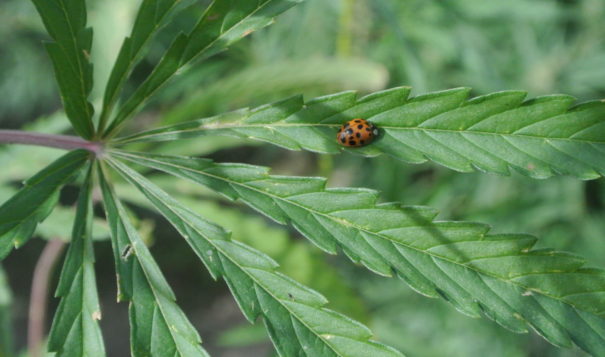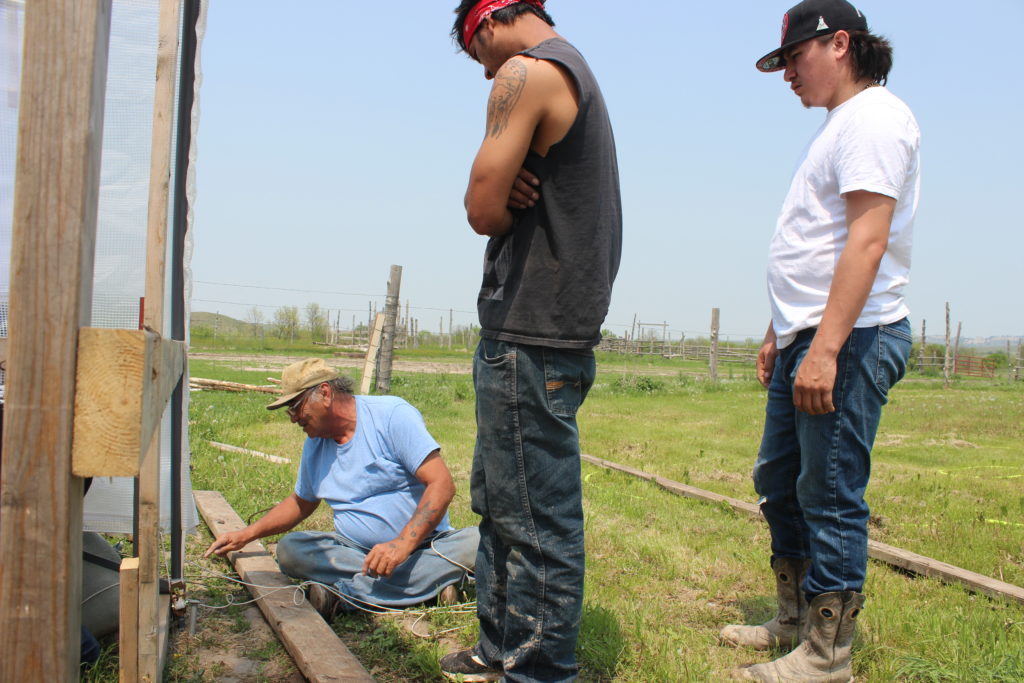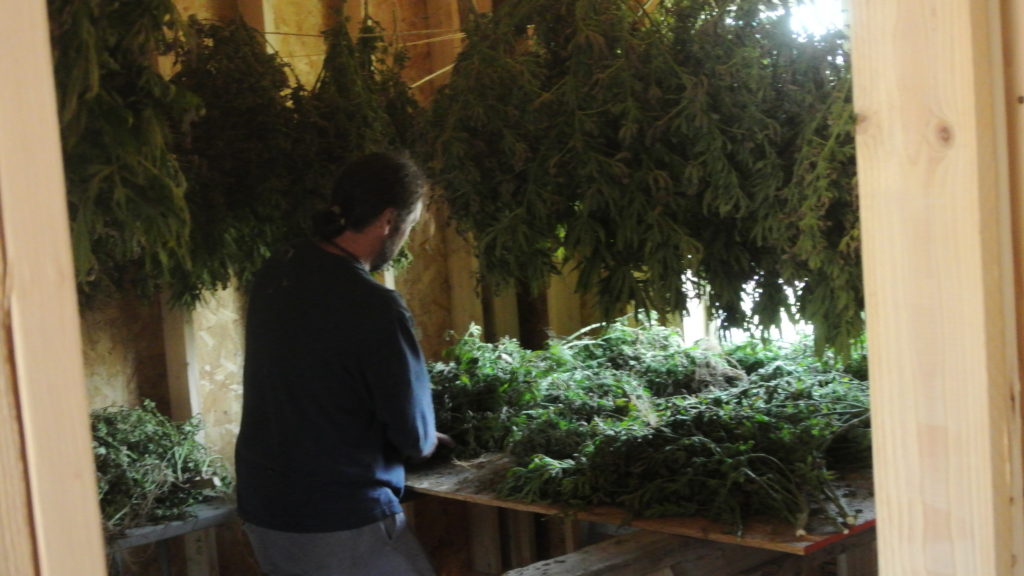News Article Article pages that do not meet specifications for other Trust Project Type of Work labels and also do not fit within the general news category.
Lakota elder planted first hemp crop nearly 20 years ago, new industry to follow
 A "lady-hemp" bug crawls on settles in on hemp leaf in Alex White Plume's hemp crop in 2017.
A "lady-hemp" bug crawls on settles in on hemp leaf in Alex White Plume's hemp crop in 2017.
BY DUANE NORIYUKI for Buffalo’s Fire
PINE RIDGE, S.D — By mid-July, the hemp plants are 2 ½ feet tall. A hailstorm threatened but didn’t damage the crop, and abundant rain has made irrigation unnecessary. Workers have been weeding the field every day, and Alex White Plume says he is happy with the crop’s progress.
It is but an acre and a half, now muddy from spring rain, on the Pine Ridge Reservation in South Dakota, but it echoes a story of hardship and faith, sovereign rights, armed federal agencies, the United Nations, the European Union in Brussels and a Lakota elder White Plume.
Near early June, the frigid northern winds have shifted to the southwest–south representing new life as the earth draws upon the sun. West representing a time of reflection and finality, the direction of the setting sun.
White Plume inhales deeply and marvels the day. In one week, it will be time to plant hemp clones on his acre and a half. It will be processed into CBD, a Cannabis extract containing little to no THC, the psychoactive component in marijuana used recreationally or medicinally.
Cannabis, a largely misunderstood plant and also one of the most diverse, is finding increased use in the form of hemp. The 2018 Farm Bill removed hemp from the list of controlled substances and placed administrative oversight to the United States Department of Agriculture, or USDA.
Farmers are approaching the hemp industry hoping it will generate more income than traditional cash crops such as corn or soy beans. Even in Oregon, where marijuana cultivation is legal, growers have created a glut, and some are considering switching to hemp.
The USDA, however, has not issued guidelines for the burgeoning industry creating a wait-and-see approach for potential growers. Until the regulations are implemented, hemp growth is limited to research and pilot programs allowed under the 2014 Farm Bill.
Erica Stark, executive director of the National Hemp Association, says acreage last year tripled or even quadrupled and is expected to grow significantly under the 2018 bill.
I’m not in it for material possessions. I’m just in it to live a happy life and one day leave my breath with a smile on my face.”
Alex White Plume, hemp grower
“It’s not certain at this point what that’s going to do for pricing. We have to see if demand will keep up with supply. There were about 80,000 acres planted across the country last year. We don’t know what the acreage will be this year.”
White Plume is considering two buyers for his crop who will process the plants for distribution as CBD, used for pain relief as well as a mounting list of potential health benefits. The growing season is less than two months long and requires a carefully timed, labor-intensive season.
“I’m in planting mode right now,” says White Plume. “You have to be totally, totally joyful, happy. You have to do it in a real good way. The plants feel that, because they’re living beings too. My kids, everybody’s doing their best to be positive, and it’s hard. It’s easy to criticize and get mad. It’s hard to remain positive.”
In 1998, the Oglala Sioux Tribal Council approved hemp agriculture on Pine Ridge, and White Plume experimented for two years before planting his first crop in 2000 with seeds harvested from feral plants growing along a Nebraska highway.
He took his shirt off and gathered seeds for his first crop. It was new to him and his brother Percy White Plume and neither was sure how to go about harvesting in a spiritual way. The plants were tall and beautiful, and as harvest neared, they had ceremonies and talked to people about how to harvest respectfully.
“We didn’t know how to have a harvest ceremony because our grandfathers were killed. All our wisdom keepers were wiped out through small pox and flu and other diseases, and downright murder. Our worry was how we could kill a plant, because it’s a living being, just like you and me. Our Sundance, we have a ceremony for taking the tree. We tell the Sundance tree, ‘We’re not taking your life. You’re going to send our voice to the universe. So we’re going to use you, and then you’re going to be part of us.’”

Four days before his 2000 harvest, federal law enforcement agencies swooped in and destroyed his crop, unknowingly reseeding his field, which resulted in his second crop. It, too, was destroyed.
He avoided criminal charges after his crops were tested and contained no THC. After his third crop was destroyed, an injunction was issued preventing the White Plumes from further involvement in hemp agriculture.
With the injunction, White Plume was thrust into a bewildering and costly judicial system and traveled twice to the United Nations and once to the European Union in Brussels. In 2016, he successfully had the injunction removed and last year planted under terms of tribal law.
This will be White Plume’s second crop since the injunction was lifted. In the past, he grew industrial hemp, used for everything from fabric to construction. This year’s conversion to CBD is a step toward his goal of developing a brand that would create jobs in an area where unemployment wavers between 85 and 95 percent.
“It’s not just about money for any one person,” White Plume says. “It’s about sharing. I could grow 200 or 300 acres of hemp and be driving a brand new pickup and live in a mansion, but I’m not in it for material possessions. I’m just in it to live a happy life and one day leave my breath with a smile on my face.”
As in all forms of agriculture, there are insects, hail and myriad risks. Memories of his first crops being destroyed remain fresh in his mind as do the financial struggles that ensued.
At one time one of the highest paid executives on Pine Ridge, White Plume saved money and built a three-story retirement house for him and his wife, water activist Debra White Plume. In 2007, a short time after completion, it burned.
He put up a garage kit and converted it into a home and sold many of his horses, setting free his prized herd of buffaloes, a sacred animal whose meat, he says, cured him of life-threatening diabetes.
“That was a stressful time. Life really beat me down that year,” he says. “No one knew what was going to happen.” Then came 2017, when his world turned inconsolable with the death of his oldest son. White Plume remains in a period of grieving.
“I have to pretend I’m happy,” he says. “I wanted to slug people who came up to me and said, ‘Tomorrow’s going to be better.’ That’s the last thing I wanted to hear.”
Healing of the soul is not so simple. The darkness is deep and cutting. White Plume felt gutted. His only relief was a story of the White Buffalo Calf Woman, who once approached a father who could not leave his son’s body. She gave the people a process for grieving and a way to free themselves from its grasp.
White Plume says his grieving period will end in about six months, and there will be a ceremony in which people gather around him and embrace him, welcoming him back after releasing his son’s spirit.
A Place to Grow
Even the name placed upon it is one of pain. Wounded Knee Creek runs through White Plume’s property. The Wounded Knee Memorial is on a hill close by commemorating the 1890 massacre in which the U.S. Calvary killed more than 250 people and wounded some 50 more.
The White Plumes have been on this land since 1890. Before his father’s death, the property grew vegetable and fruit crops to sustain them year-round. At the foot of a grass-covered hill, White Plume stands in front of a house he made of hemp for Debra and looks at a single pine tree standing at the top of a hill.
“My father used to have me run up to that tree and back,” he says. He looks at grass fields that once grew potatoes and corn, all types of fruit and vegetables. “When he died, everything seemed to fall apart.”
By the time he was 16, both parents had died, and he became caretaker for eight younger siblings. Another family moved into their home and put all the White Plume possessions outside. White Plume moved his siblings into dirt dugouts on the land until they were able to reclaim their property.
He quit school in ninth grade to care for his siblings and later served in the military, earned his high school GED and two, two-year degrees. He was the first certified Montessori teacher on Pine Ridge and served as a tribal leader, but most of his efforts have involved teaching the largely forgotten Lakota language.
White Plume is a storyteller, combining the roles of elder, historian and teacher. It is through stories, rather than written word, that Lakota values and beliefs are handed down generationally.
That’s what’s really historically significant here, that we have prayed for the spirits to bring us hope. That’s the legacy we live with here.
Alex White Plume, Lakota Elder
It is a revered role to describe old ways so that current and future generations might reclaim their identity, and, in doing so, escape conditions that systematically and, sometimes, violently devastated the community.
As a child, White Plume’s first language was Lakota. Other children made fun of his accent, but he kept the language and culture—the stories—in his soul like treasures.
The Battle of Wounded Knee resulted from suspicion over the Ghost Dance. Although it was a ceremony honoring ancestors, encroaching soldiers believed it to be preparation for attack. The Ghost Dance was conducted five miles from White Plumes’ house.
“I think the importance of it was they prayed out of desperation for a way to live. The military surrounds you, points guns at you. ‘Be a good little Indian and you’ll get your rations.’ That’s what’s really historically significant here, that we have prayed for the spirits to bring us hope. That’s the legacy we live with here.”
The pain of losing a child is not unique to any group of people. For White Plume, the pain is ever-present. In accordance with tradition, he has isolated himself so his shadow of grief isn’t cast upon others. In about six months, he says, there will be a ceremony in which his son’s spirit will be freed, and he will end his grieving.
He is by nature a man known for the wisdom of his stories, for his advocacy, commitment to Lakota ideals and for his galvanizing sense of humor. On planting day, he will sit in front of a tipi, made of hemp, as the plants are honored with drums and prayers. A staff placed in the center of the field. This acre and a half is about much more than hemp.
Native Hemp Industry
Aaron Fournier of Native American Hemp in Oklahoma says industrial hemp, which is biodegradable, can reduce dependence on oil-based products such as plastic and biofuel. “My company sees this as an opportunity that could have the same impact as casinos for some tribes in more rural communities,” he says.
The primary advantage reservations have, he says, is that they are not taxed. “The real impact that we’re hoping to see is that tribes take advantage of the tax benefits…They are able to undercut the competition, and they could really own this whole sector.”
Fournier says the long-term goal is to include processing and manufacturing facilities on or near reservations. In doing so jobs would be created for wide-ranging needs, providing employment for people of all education levels.
For the next three to five years, Fournier says, there will be growing pains. He warns that growers must be knowledgeable and prepared before entering the hemp business. Vote Hemp, a non-profit advocacy organization predicts that CBD retail sales will double by 2022.
“There’s going to be a lot of businesses open and many that will close,” he says. “Many things are up in the air. It’s a little bit of a

First Light
On planting day, family members and friends show up at the acre and a half. White Plume has 37 grandchildren and 17 great grandchildren. About one-half of them, he says, will work on the crop.
With a staff placed in the middle of the field, drummers play and sing in prayer as White Plume and Debra sit in front of a tipi made of hemp. His demeanor is joyful and excited, dampened by the grief of a lost son.
‘First light,” Debra says, welcoming the plants, their new neighbors. They will be grown with respect and hope that the crop will transform into goodness for the people.
For Tyler White Plume, 24, this is his first crop since taking over the business. He helped his grandfather last year but says he still has much to learn. He is being assisted by Charles Camp, also 24. Both were raised by White Plume. Camp moved back to Pine Ridge this season after working for activist/environmentalist Winona LaDuke, who farms hemp on the White Earth reservation.
“This means a lot,” the younger White Plume says. “It could put us on the map. Everyone’s happy. The plants are happy. They were just little babies when they got here, but they’re growing fast.”
Duane Noriyuki is the co-founder of InsideOUT Writers. He has also worked internationally for the Los Angeles Times, Detroit Free Press, St. Paul Pioneer-Press, and small newspapers throughout Colorado, including the Aspen Times.
